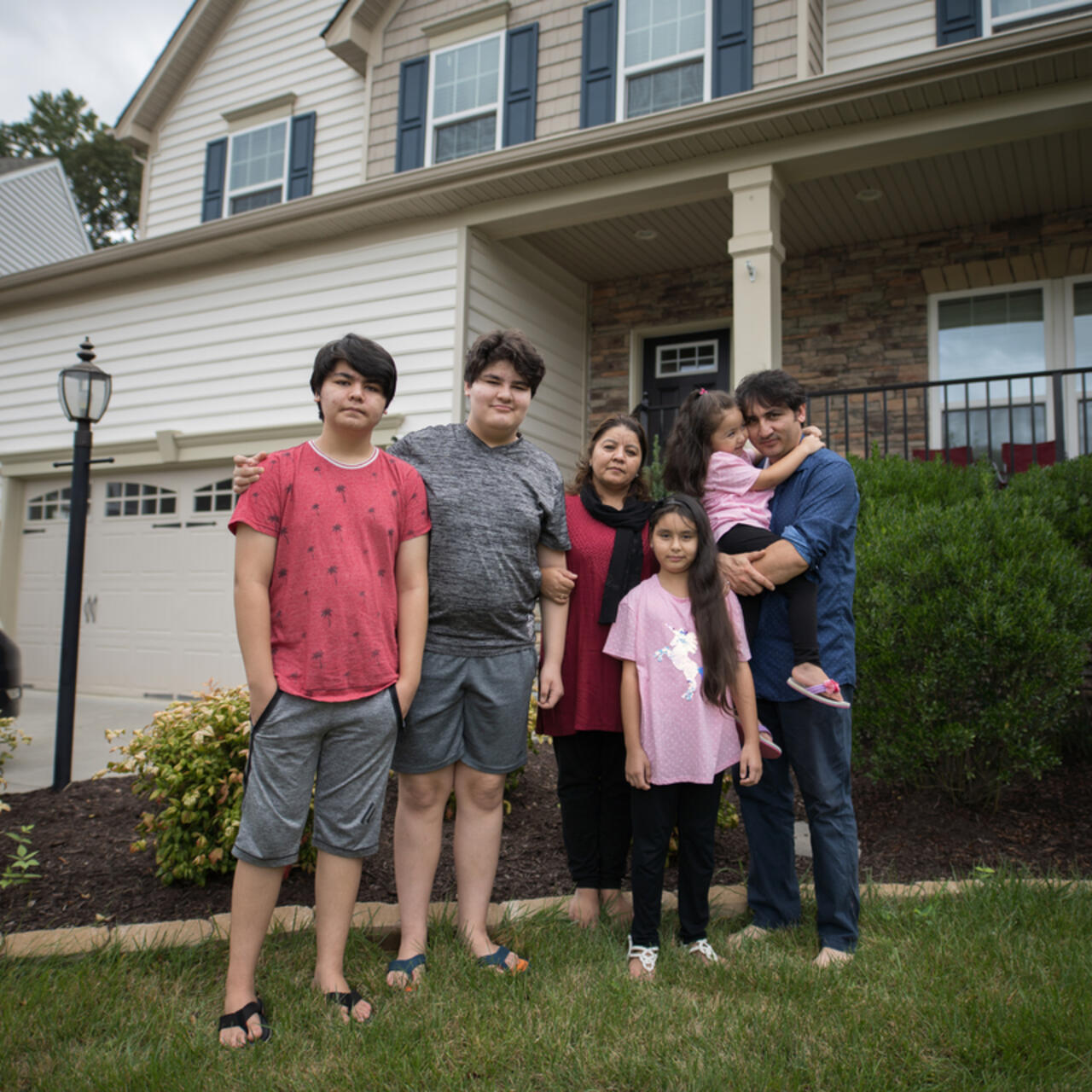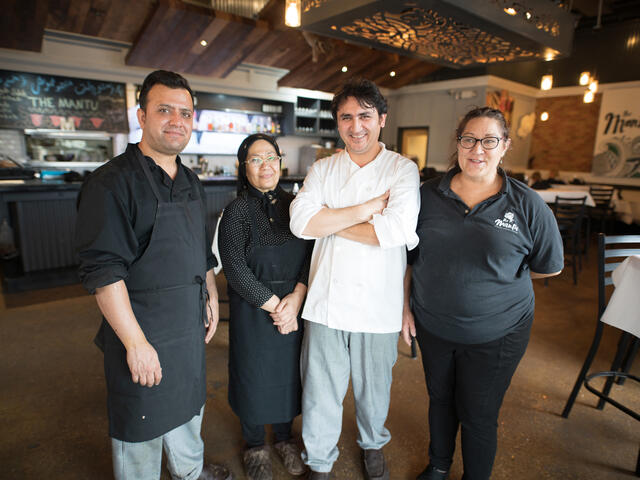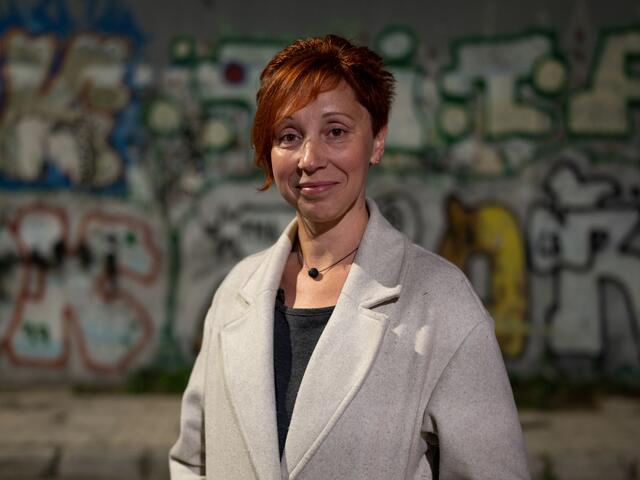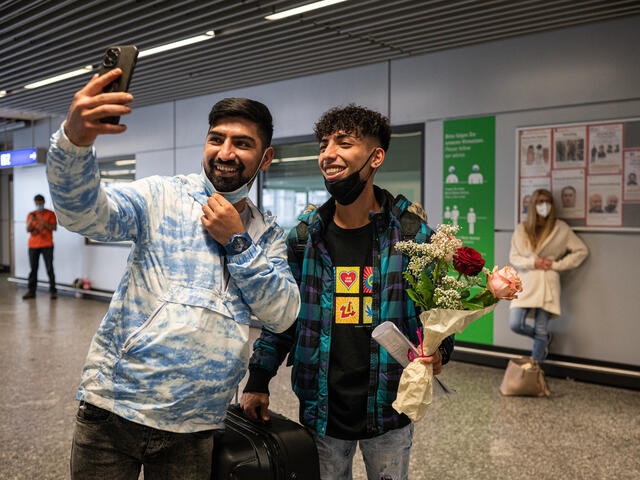
What are safe pathways to protection?
Exploring different tools designed to support people seeking protection including resettlement, complementary pathways, and family reunification.

Exploring different tools designed to support people seeking protection including resettlement, complementary pathways, and family reunification.
For most refugees, their journey to safety does not end when they arrive in a new country.
The reality is that a total of 76% of refugees worldwide are hosted by low and middle-income countries - many of which face difficulties such as conflict, economic instability, hunger and health crises that limit their ability to adequately support and protect refugees.
This is why safe pathways to protection - also known as “legal pathways” - are so important. These are specific tools designed to relocate people from a place where they are at risk to another country of relative safety where they can begin to recover and rebuild their lives.
Every safe pathway offers a vital lifeline, giving people a chance to make a home, and contribute to their new communities. At the same time, they are an important expression of international solidarity that can alleviate pressure on major refugee-hosting countries like Türkiye, Lebanon, Pakistan and Uganda.
But what are these ‘safe pathways’ and how do they work? In this article we will explore three of these tools designed to support people seeking protection in Europe: Resettlement, complementary pathways, and family reunification.
It’s important to remember that while these safe pathways are critical, they do not replace the legal right for anyone to claim asylum - regardless of where they are from, or how they arrive in Europe.
Refugee resettlement provides a durable solution for refugees who are outside of the EU, in particularly vulnerable situations, and who do not have adequate support in their host countries.
Under resettlement, some of the most vulnerable refugees who remain stranded in low- and middle-income regions are transferred to safe countries elsewhere - such as EU member states, Canada, the UK or the US - where they are granted a pathway to permanent residence.
Resettlement countries volunteer to commit to accepting a certain number of refugees each year. The UN refugee agency, UNHCR, refers refugees to these states, who then choose who they admit, according to their own national criteria.
According to UNHCR, the majority of people in need of resettlement today originate from Syria, Afghanistan, the Democratic Republic of the Congo, South Sudan and Myanmar.
While some countries have made significant resettlement commitments in recent years, others have not pledged to resettle a single refugee despite soaring levels of need worldwide. Worryingly, many of the states who have made commitments have failed to meet them.
In 2022, EU states resettled 16,695 refugees - only 1.1% of the 2 million refugees in need of resettlement worldwide. It can and must do more.
The IRC is calling for EU member states to significantly ramp up their resettlement pledges in line with their true capacity to welcome. This includes committing to resettle at least 44,000 refugees in 2024, and pledging a minimum of 8,500 additional places for Afghan refugees.
Read more about refugee resettlement and how it benefits the EU.

Complementary pathways is a term used to describe a number of additional legal protection pathways created by some countries that allow refugees matching specific criteria to come to their territory to live, work or study. They are called ‘complementary’ because they are meant to come alongside (and in addition to) refugee resettlement, which is a vital tool reserved for those most vulnerable.
Labour schemes enable refugees with specific, in-demand skill sets to settle in a new country and enter the job market. Labour schemes can be of differing duration – many range from six months to two years, while others offer permanent residency upon arrival.
In the EU, examples of labour schemes include the Displaced Talent for Europe pilot project which enables displaced people in Jordan and Lebanon to connect and find work with employers in Europe.
Conservative estimates reveal that there are at least 600,000 refugees across the globe who could qualify for skilled immigration programmes and fill labour shortages immediately based on their educational and professional backgrounds.
Similarly, study schemes allow refugees to come to a new country as part of a sponsorship programme and benefit from higher learning scholarships. These schemes can be operated by individual universities and other higher education institutions, sometimes with the help of funding from national and local governments or private foundations.

In the EU, several higher education institutions including in Germany, Spain, France, and Italy offer study pathways for refugees.
Another, different criteria for complementary pathways is ‘humanitarian admission’ which occurs when emergency situations such as conflict or environmental catastrophe create a sudden group of vulnerable, at-risk people who require urgent relocation.
The EU’s enacting of the Temporary Protection Directive in response to people fleeing Ukraine in 2022 is an example of a humanitarian admissions initiative. Since 2022, over 5 million people have arrived in Europe via this pathway.

Another example is the thousands of Afghans arriving to the EU via ad-hoc evacuations from Afghanistan in August 2021, many of whom were received via humanitarian admission.
In 2022, several EU countries launched dedicated humanitarian admission schemes to support Afghans to access safety and rebuild their lives, including Germany, Ireland, and Italy. While some of these have been slow to materialise, between 2021 and 2022, about 41,500 Afghans at risk were admitted to the EU through these vital programmes.
Humanitarian admissions do not usually lead to permanent residency and are based on the assumption that beneficiaries will return to their country of origin once the initial crisis has passed.
Community Sponsorship is a term used to describe a wide array of public-private partnerships between governments and private or community actors (sponsors), who provide integration, financial, practical, and emotional support for refugees.
These types of initiatives, which can be ‘sponsored’ by private citizens, religious and other communities, and civil society organisations, are often linked to and meant to support other pathways.
Examples of community sponsorship include local groups committing to mentor a newly resettled refugee, support new arrivals to learn a language, or host a refugee student who is taking part in a study scheme.
Like resettlement, complementary pathways are voluntary and an expression of international solidarity in response to the growing needs of displaced people seeking protection worldwide.
Family reunification is a tool used to bring together families who have been separated. Under this process, recognised refugees and other beneficiaries of international protection are eligible to bring their family members (usually children, spouses and elderly dependents) to the country in which they are living.
Their family members do not need to have received refugee status in order for this to happen.
The family members permitted through reunification schemes vary region to region, country to country, but are typically restricted to immediate rather than distant family members.
Unlike resettlement and complementary pathways, family reunification is typically enshrined in law as a right in EU and international law.
In 2021, EU countries admitted approximately 38,000 people on the basis of family reunification.

Read the story of Ali and Mehdi - two Afghan brothers who were reunited in Germany after being separated for 11 years.
As the number of displaced people continues to climb year after year, it is vital for the international community - including the EU - to expand the number of safe, regular pathways to protection each year.
Despite this, EU member states have consistently missed opportunities to strengthen schemes to move people to safety in Europe.
With more people displaced than ever before, IRC is calling on the EU and its member states to urgently: